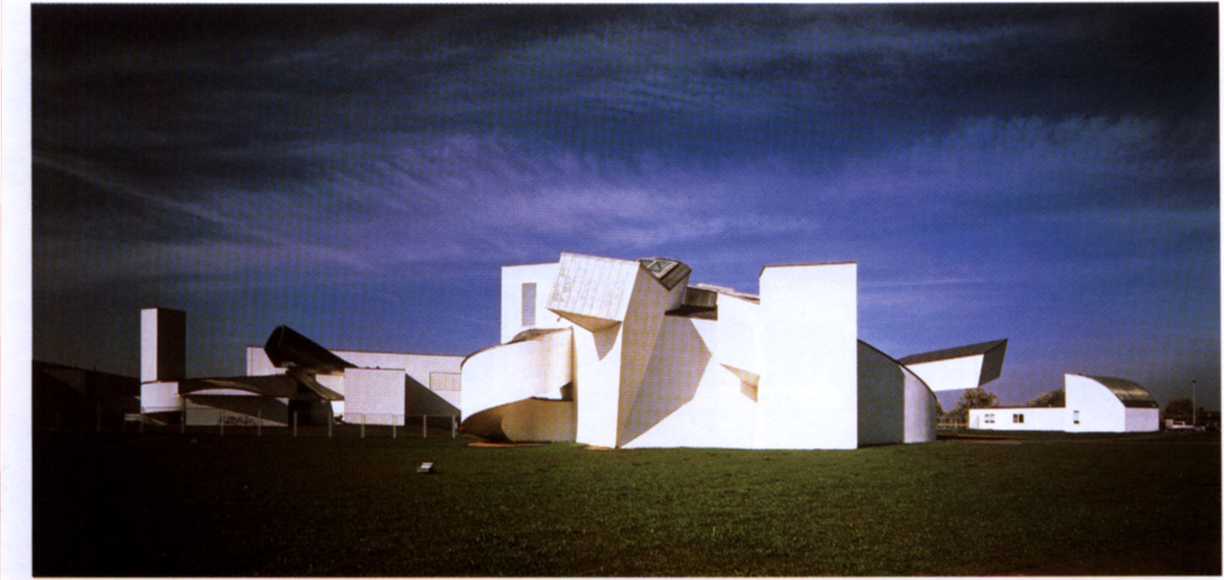New Forms Taschen 008


One of Frank O. Gehry's morę successful buildings is his Vitra Design Museum in Weil am Rhein, Germany, just over the border from Basel, Switzerland. Its interior has been compared to Kurt Schwitter's Merzbau (Hanover), and Gehry himself has spoken of "frozen motion" in referring to this building. Neither these references, nor the twisted volumes of the exterior of this 1989 structure, immediately cali to mind the superposed diagonals said to be typical of Deconstructivist architecture. The reason for this apparent paradox is quite simple. Gehry's exploration of new forms is as much a product of the study of contemporary art as it is related to Russian Constructivism or German Expressionism. Both of those movements of course at-tempted to integrate architecture and art into a single effort to create the new.
Another of MoMA's seven is Zaha Hadid, born in Baghdad in 1950. Having stud-ied under Rem Koolhaas at the Architectural Association (AA) in London, she went on to be one of the morę influential exponents of the new status of architects as artists. In fact from the first, which is to say her 1983 first prize entry for the Peak Club in Hong Kong, Zaha Hadid has been almost better known for her drawings, ex-ecuted in a style that has been called "exploded isometric projection," than for her rare built work. Her 1993 Vitra Fire Station, on the same Weil am Rhein site as Gehry's Design Museum, is the proof that she is capable of converting her unusual vision of architecture for a fragmented, unstable society into concrete, Steel and glass. It is both visually arresting and apparently quite functional despite a number of diff icult-to-use sharp interior corners.
Hadid's teacher at the AA, the Dutch architect Rem Koolhaas, is one of the morę flamboyant figures of his generation. Born in Rotterdam in 1944, he too has only re-cently had the opportunity to translate theoretical ruminations into rather spec-tacular built form with the Euralille complex in northern France, and in particular with the Grand Palais, an enormous exhibition hall and conference center. Rem Koolhaas first achieved public attention with the 1978 publication of his book Delirious New York in which he argued that America's most important contribution to urban design has been what he called "Manhattanism" - the congested high-rise cores of the largest cities. His theory is that that the glory of the city lies in the ex-ceptional, the excessive, the extreme, in what he calls the "Culture of congestion." He proposes collaborating with, if not emulating, uncontrolled forces of develop-
Pages 10/11
Frank O. Gehry
Vitra International Furniture
Manufacturing Facility and
Museum
Weil am Rhein, Germany, 1986-89
The Vitra Design Museum serves mainly to exhibit the f irm's large collection of chairs. Despite the apparent complexity of the structure. it functions well as a display facility, and is not plagued by un-usable interior spaces. Sculptural in its volumes, Gehry's architecture here comes close to mostly unbuilt designs of the 1920s and 1930s, and goes beyond the vocabulary of lightweight materials that he pioneered in the warm Southern California climate.
io Introduction
Wyszukiwarka
Podobne podstrony:
62302 New Forms Taschen 079 California architect Frank O. Gehry this trend has been a source of some
86027 New Forms Taschen 011 Zaha Hadid Vitra Fire Station Weil am Rhein, Germany, 1988-93 Part of th
New Forms Taschen 207 Pagei218/219 Alvaro Sira Factory for Vitra Weil am Rhein, Germany, 1992-9
New Forms Taschen 037 emphasized again here that aside from France, The Netherlands may be one of th
New Forms Taschen 071 Holi is one of the morę thoughtful contemporary architeas. He has written, &qu
New Forms Taschen 037 emphasized again here that aside from France, The Netherlands may be one of th
więcej podobnych podstron